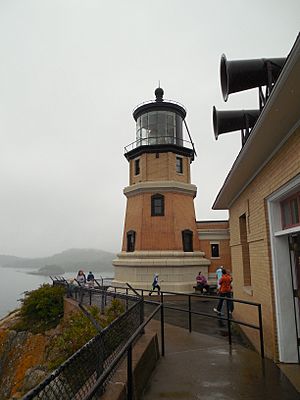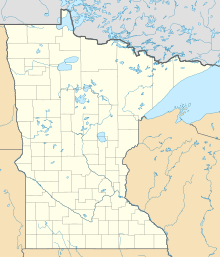Split Rock Lighthouse facts for kids
|
|
|
| Location | Split Rock Lighthouse State Park, Beaver Bay Township, Lake County, Minnesota |
|---|---|
| Coordinates | 47°12′00″N 91°22′01″W / 47.20005°N 91.3669°W |
| Year first lit | 1910 |
| Deactivated | 1969 |
| Foundation | stone |
| Tower shape | Octagonal |
| Height | 54-foot (16 m) tower on a 130-foot (40 m) cliff |
| Original lens | 3rd order, bi-valve type Fresnel lens |
| Range | 22 nautical miles (41 km; 25 mi) |
| Characteristic | 0.5-second flash every 9.5 seconds |
| ARLHS number | USA-783. |
|
Split Rock Lighthouse
|
|
| Nearest city | Two Harbors, Minnesota |
| NRHP reference No. | 69000073 |
| Significant dates | |
| Added to NRHP | June 23, 1969 |
| Designated NHL | June 23, 2011 |
 |
|

Visitors at Split Rock Lighthouse.
Fog Horn House in foreground. |
|
| Established | 1969 |
|---|---|
| Location | 3713 Split Rock Lighthouse Rd., Two Harbors, Minnesota USA |
| Type | History Museum |
| Visitors | 160,000 |
The Split Rock Lighthouse is a famous lighthouse located in Minnesota, USA. It stands on the North Shore of Lake Superior, near Silver Bay. This beautiful lighthouse was designed by engineer Ralph Russell Tinkham. It was finished in 1910 and cost about $75,000, which included all the buildings and the land. Many people think it is one of the most scenic lighthouses in the United States.
Contents
Why Was Split Rock Lighthouse Built?
The Split Rock Lighthouse was built because of a terrible storm in 1905 called the Mataafa Storm. During this storm, 29 ships were lost or damaged on Lake Superior. One of these ships, the Madeira, sank just north of where the lighthouse now stands. This event showed how much a lighthouse was needed in this dangerous area.
How the Lighthouse Was Constructed
The lighthouse sits on a very tall cliff, about 133 feet high. This cliff was shaped by waves hitting a hard rock layer. The lighthouse building itself is octagonal, meaning it has eight sides. It is made of brick with a steel frame and concrete parts. It sits on a strong concrete base built into the cliff rock.
On top of the tower is a large steel lantern. Inside this lantern is a special Fresnel lens. This lens was made in Paris, France. It was designed to be a second-order lens, but because the building went over budget, a slightly smaller third-order lens was used instead.
How the Light Worked
The lens of the lighthouse floats on a pool of mercury. This allows it to turn very smoothly with almost no rubbing. The lens was rotated by a clever clockwork system. This system used heavy weights that would slowly drop down the center of the tower. To reset it, keepers would crank the weights back up to the top. When it was first built, the lighthouse used a kerosene oil lamp to create its powerful light.
Getting Supplies to the Lighthouse
When the lighthouse was being built, there were no roads to the area. All the building materials and supplies had to come by water. They were then lifted to the top of the cliff using a crane. The light was first turned on for ships on July 31, 1910.
Because of its amazing location, the lighthouse quickly became a popular spot for tourists. Sailors and people on excursion boats loved to visit. So many people wanted to see it that in 1924, a road was built to allow people to drive there. This road is now Minnesota State Highway 61.
Changes Over Time
In 1940, the lighthouse got electricity. The old kerosene lamp was replaced with a bright 1000-watt electric bulb. The original oil lamp was then moved to another lighthouse in Michigan.
A fog signal was also added next to the light tower. At first, it used two sirens powered by gasoline engines. Later, in 1932, these were changed to diesel engines. In 1936, the old sirens were replaced with a different type of fog signal called a diaphone. This signal made a loud "be-you" sound. The fog signal also became electric four years later, but it was stopped in 1961.
Split Rock Lighthouse Today
The U. S. Coast Guard stopped using the lighthouse in 1969. Today, Split Rock Lighthouse is part of the Split Rock Lighthouse State Park. It is managed by the Minnesota Historical Society. The site has the original tower and lens, the fog signal building, the oil house, and the three houses where the lighthouse keepers lived. It has been restored to look just like it did in the late 1920s.
The lighthouse was added to the National Register of Historic Places in 1969. Even though it's not used for navigation anymore, every November 10, the lighthouse shines its light. This is done to remember the SS Edmund Fitzgerald, a ship that sank on that date in 1975. On June 30, 2011, the lighthouse was named a National Historic Landmark.
Lee Radzak was the lighthouse keeper from 1982 to 2019. He was the longest-serving keeper at Split Rock Lighthouse.
Split Rock Lighthouse in Art and Movies
The United States Postal Service featured Split Rock Lighthouse on a postage stamp on June 17, 1995. It was one of five lighthouses chosen for the "Lighthouses of the Great Lakes" stamp series. Each of the Great Lakes had one lighthouse chosen for the stamps. The other lighthouses were St Joseph Light on Lake Michigan, Spectacle Reef Light on Lake Huron, Marblehead Light (Ohio) on Lake Erie, and Thirty Mile Point Light on Lake Ontario.
Because it is so beautiful, Split Rock Lighthouse has been in many photographs and on many postcards. It was even shown in the 2013 movie The Great Gatsby.
Gallery
Images for kids













